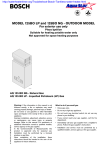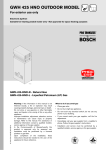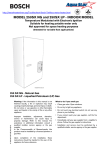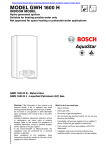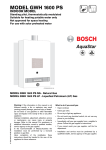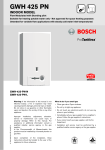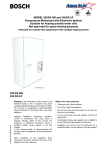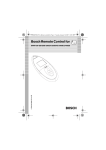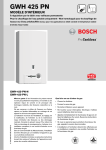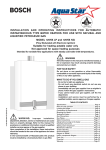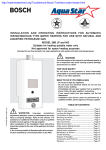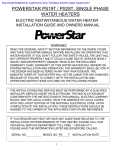Download Bosch 2400 EO NG Specifications
Transcript
http://waterheatertimer.org/Troubleshoot-Bosch-Tankless-water-heater.html MODEL 2400 EO - OUTDOOR MODEL For exterior use only Electronic Ignition and built in Freeze protection Suitable for heating potable water only Not approved for space heating purposes 2400 EO NG - Natural Gas 2400 EO LP - Liquefied Petroleum (LP) Gas 6 720 608 257 US (06.11) JS Warning: If the information in this manual is not followed exactly, a fire or explosion may result causing property damage, personal injury or death. Do not store or use gasoline or other flammable vapor and liquids in the vicinity of this or any other appliance. Improper installation, adjustment, alteration, service or maintenance can cause injury or property damage. Refer to this manual. For assistance or additional information consult a qualified installer, service agency or the gas supplier. In the Commonwealth of Massachusetts this product must be installed by a licensed plumber or gas fitter. Upon completion of the installation, these instructions should be handed to the user of the appliance for future reference. What to do if you smell gas • Close gas valve. • Do not try to light any appliance. • Do not touch any electrical switch; do not use any phone in your building. • If you cannot reach your gas supplier, call the fire department. • Immediately call your gas supplier from a neighbor’s phone. Follow the gas supplier’s instructions • Installation and service must be performed by a qualified installer, service agency or the gas supplier. Index Index 1 Warning 2 2 2.1 2.2 2.3 2.4 2.5 2.6 2.7 2.8 2.9 2.9.1 2.9.2 2.9.3 2.10 2.11 2.12 2.13 2.14 Appliance details Features 2400 EO Specifications (Technical data) Dimensions and Minimum installation clearances General rules to follow for safe operation Proper location for installing your heater Heater Placement and Clearances Mounting installation Gas piping & connections Measuring gas pressure Connecting Manometer Static Pressure Test Operating Pressure Test Water connections Electrical connections Operating instructions For your safety read before operating your water heater Lighting and operating instructions 15 15 3 3.1 3.2 3.3 3.4 3.5 3.6 3.7 Operation instructions Power Temperature selection Use of remote control accessory Operation Reset button Program button Locked condition 16 16 16 18 18 18 18 18 4 Maintenance and service 19 5 Troubleshooting 19 6 Electrical diagram 22 7 2400 EO Functional scheme 23 8 8.1 8.2 8.3 Interior components diagram and parts list Interior components Components diagram Parts list 24 24 25 26 9 Special adjustment for measuring and adjusting CO2 levels 27 10 Protecting the environment 29 11 Twelve Year Limited Warranty 30 4 4 4 6 7 7 8 8 10 12 12 12 12 13 14 14 1 Warning Warning: If the information in this manual is not followed exactly, a fire or explosion may result causing property damage, personal injury or death. Warning: Improper installation, adjustment, alteration, service or maintenance can cause injury or property damage. Refer to this manual. For assistance or additional information consult a qualified installer, service agency or the gas supplier. Upon completion of the installation, these instructions should be handed to the user of the appliance for future reference. Featuring Electronic Ignition and Power Venting. 2 For your safety Do not store or use gasoline or other flammable, combustible or corrosive vapors and liquids in the vicinity of this or any other appliance. Warning: Carefully plan where you install the heater. If a gas appliance is not installed correctly, fatal accidents can result from lack of air, carbon monoxide poisoning or fire. Warning: Place the heater in a location where water leaks will do NO DAMAGE to adjacent areas or floors. Warning: Field wiring connections and electrical grounding must comply with local codes, or in the absence of local codes, with the latest edition of the National Electric Code, ANSI/NFPA 70, or in Canada, all electrical wiring must comply with the local codes and the Canadian Electrical Code, CSA C22.1 Part 1. Warning: Shock hazard line voltage is present. Before servicing the water heater, turn off the electrical power to the water heater at the main disconnect or circuit breaker. Failure to do so could result in severe personal injury or death. 6 720 608 257 Warning What to do if you smell gas • Close gas valve. • Do not try to light any appliance. • Do not touch any electrical switch; do not use any phone in your building. • Immediately call your gas supplier from a neighbor’s phone. Follow the gas supplier’s instructions. • If you cannot reach your gas supplier, call the fire department. • Installation and service must be performed by a qualified installer, service agency or the gas supplier. Warning: The heater must be disconnected from the gas supply piping system during any pressure testing of that system at test pressures equal to or more than 0.5 psig. FCC: This device complies with Part 15 of the FCC rules. Operation is subject to the following two conditions: (1) This device may not cause harmful interference, and (2) this device must accept any interference received, including interference that may cause undesired operation. Caution: Any changes or modifications not expressly approved by the party responsible for compliance could void the user’s authority to operate the equipment. Fig. 1 Fig. 2 6 720 608 257 3 Appliance details 2 Appliance details 2.1 Features 2.2 Parts 2400 EO Specifications (Technical data) • Touch Pad interface control Approved in US/Canada • High power pre-mix compact burner with low NOx emissions Capacity • Modulating Gas Valve with constant gas: air ratio control • Modulating water valve for improved comfort and temperature control Maximum flow rate: 6.35 GPM (24 l/min) at a 45°F (25°C) rise. Maximum output 142,968 Btu/h (41.8 kW) • Freeze protection. Maximum input Safety 175,000 Btu/h (51.2 kW) • Flame sensor (ionization) rod Efficiency in % • Overheat sensor Recovery efficiency 86.5% • Temperature limiter Min. Output • Fan speed monitoring. 31,131 Btu/h (9,1 kW) High Quality Materials for Long Working Life Temperature Control • Copper heat exchanger Selection range: 100°F (38°C) - 140°F (60°C) • High efficiency Ceramat Burner Default temperature: 122°F (50°C) • Compact space saver: mounts on a wall with a supplied bracket. Stability: +/- 2°F (+/- 1°C) • Easily removable two-piece cover. Features • Electronic Ignition • LCD Display • On/Off and Temperature control switches • Reset button • Program Key (Selectable temperature default) • Failure codes for easy diagnostic and repair. Accessories • Optional wireless remote control accessory to operate with the appliance. i BOSCH is constantly improving its products, therefore specifications are subject to change without prior notice. Gas Requirement Gas connection (inches) - ¾” Inlet gas pressure under maximum operation* • Propane: 11” - 14” water column • Natural Gas: 5” - 14” water column. * To measure Gas Pressure, see Measuring Gas Pressure, chapter 2.9. Water • Hot water connection (inches) - ¾” • Cold water connection (inches) - ¾” • Water valve material: Polymer (PPS) (Polypropylene Sulfid) • Minimum water flow: 0.8 gallon/minute (3 l/m) • Minimum recommended water pressure: 30 PSI (2.07 bar) • Connections: – Bottom of heater 4 6 720 608 257 Appliance details Combustion UNPACKING THE 2400 EO HEATER • NOx ≤ 55 ppm This heater is packed securely. • CO ≤ 250 ppm. The box includes: Dimensions • Control panel shield • Depth (in): 8 ½” (220 mm) • Width (in): 15 ¾” (400 mm) • Height (in): 26” (650 mm) • Weight: 47 pounds (21 kg). Gas types Natural Gas. LP Gas. CO2 analyzer is required to convert from one gas type to another. Please contact BBTNA for specific instructions. Voltage 120 V AC (50/60 Hz) Amperage • Pressure relief valve • Bracket for wall hanging the heater • Plastic decal shields for covering front cover screws and control panel, installer should affix these decals to the front of the unit after installation is complete. See Fig. 6 • Installation manual • Product registration card. Do not lose this manual. Please complete and return the enclosed product registration card. Before installing the unit, be certain you have the correct heater for your type of Gas - Propane or Natural Gas. Identification labels are found on the shipping box, and on the rating plate which is located on the right side panel of the cover. IDLE - 40 mA Operation - ≤ 2,5 A Noise ≤ 50 db (A) The 2400EO is not approved or designed for: Safety devices • Manufactured (mobile) homes, RV's or boats • Flame failure device (ionization flame rod sensor) • Heating or other recirculating/pumping applications* • Pressure relief valve (supplied with heater) • Solar/preheat backup or high temperature booster use * This includes domestic hot water circulator pump loop systems that may previously exist in a home hot water system. The use of a small electric mini-tank (4-6 gallon size) should be used for this application; when designed so the pump will circulate the hot water in the mini-tank only and through the building's hot water return loop (timed or thermostatic controlled operation of the pump is commonly done). The 2400EO should be plumbed in line before the mini-tank water heater, contact BBTNA if further instruction is needed. • Over heat prevention (temperature limiter). Water resistant IP X5 (protection against water drops). 6 720 608 257 5 Appliance details 2.3 Fig. 3 1 2 3 4 5 6 Dimensions and Minimum installation clearances Dimensions Cover On/Off switch Reset button LCD display Program button Temperature buttons Fig. 4 Minimum clearances Model 2400 EO TOP (A) 3 ft. FRONT (B) 4 ft. BACK 0” SIDES 4 ft. BOTTOM (C) 1 ft. Table 1 Minimum clearances 6 6 720 608 257 Appliance details 2.4 General rules to follow for safe operation B 1. You should follow these instructions when you install your heater. In the United States: The installation must conform with local codes or, in the absence of local codes, the National Fuel Gas Code ANSI Z223.1/NFPA 54. In Canada: The Installation should conform with CGA B149.(1,2) INSTALLATION CODES and /or local installation codes. B 2. Carefully plan where you install the heater. Proper clearances must be followed. B 3. The appliance must be isolated from the gas supply piping system by closing its individual manual gas shutoff valve (not supplied with heater) during any pressure testing at pressures in excess of ½ Psig (3.5 kPa). The appliance and its gas connection must be leak tested before placing the appliance in operation. B 4. Keep water heater area clear and free from combustibles and flammable liquids. Do not locate the heater over any material which might burn. B 5. Correct gas pressure is critical for the optimum operation of this heater. Gas piping must be sized to provide the required pressure at the maximum output of the heater, while all the other gas appliances are in operation. Check with your local gas supplier, and see the section on connecting the gas supply. B 6. Should overheating occur or the gas supply fail to shut off, turn off the gas supply at the manual gas shut off valve, on the gas line. Note: manual gas shutoff valve is not supplied with the heater. B 7. Do not use this appliance if any part has been underwater. Immediately call a qualified service technician to inspect the appliance and to replace any part of the control system and any gas control which has been underwater. 2.5 Proper location for installing your heater Carefully select the location of the water heater. Follow the guidelines below: B 1. Locate the heater where venting, gas and plumbing connections are feasible and convenient. B 2. The hot water lines should be kept short to save energy. Centrally locating the water heater is best. It is always best to have the water lines insulated to prevent the possibility of any freeze damage. B 3. The water in this heater is cold and always remains cold except for the times that hot water is being used. The heater is equipped with freeze prevention equipment that will operate and prevent freezing of the water in the heater to 5°F with no wind chill. Electrical power must be maintained to the heater to allow this to function. 6 720 608 257 WARNING: Proper insulation of the water lines below the heater is required if below freezing temperatures, below 32°F, are ever anticipated! Danger: If the temperature drops below 5°F, freeze damage to the water heater itself must be prevented by turning off the power to the heater, then disconnecting the plumbing connections and introducing short bursts of compressed air (20-40 psi) through the heater's connections. This will remove the residual water in the horizontal pipes and water valve.. Danger: Keep children away as the top of the water heater vent cap will get very hot during operation. Install in a place that prevents the top of the heater being reached by small children. Danger: Flue gases will be released through the vent cap. Flue gas is very hot and contains carbon monoxide. The heater cannot be installed indoors. To prevent risk of fire and poisoning by carbon monoxide, assure all clearances indicated in manual. Danger: Surface temperature around vent cap is less than 140°F, except highest top surface of vent cap may reach 400°F. Danger: Do not place or store any combustible material within 5 feet of the appliance. Risk of fire could be caused by hot flue gas. Note: Exception is made for the wall where the appliance is installed and any adjacent walls or overhang. In this case observe clearances required in chapter 2.6. Warning: Flammable materials, gasoline, pressurized containers, or any other items or articles that are potential fire hazards must NOT be placed on or adjacent to the heater. The appliance area must be kept free of all combustible materials, gasoline and other flammable vapors and liquids. 7 Appliance details 2.6 Heater Placement and Clearances 2.7 The 2400 EO is design certified for installation directly on a combustible wall. (see 2.7 Mounting installation) For installation on vinyl siding see Fig. 10. Keep the area below the heater free of combustible material. Mounting installation Warning: before starting installation: B check that there are no loose parts inside the appliance B ensure that gas pipe, gas valve, mixer, fan and burner have no damage and are properly fitted. Minimum clearances If the appliance is installed under an overhang, there must be a 36” clearance from the top of the appliance and the mounting area must be open in front and on the sides of the appliance. i Front cover should be removed in order to inspect components visually (see instructions below). To remove front cover. B Loosen the two Philips head screws located on front panel (beneath plastic decal shields if they are already attached, see Fig. 6). Plastic decals Fig. 5 Danger: The top of the kit will get hot due to the flue gases. Install away from children. Ref. Description Min. distances A Directly below or from an opening; operable windows, doors and any fresh air openings ≥ 4 ft Fig. 6 D From any adjacent wall or tall shruberry ≥ 4 ft B Remove the two top screws securing the vent cap to the top of the heater, being careful the washers on the screws are not lost, see Fig. 7. E Below a gutter, sanitary pipework, eaves or overhang ≥ 3 ft F Above ground ≥ 1 ft G From a gas meter, gas regulator, electrical box or another 2400EO heater ≥ 3 ft B C Remove front cover Table 2 Clearances Fig. 7 B Lift the top vent cap completely upward from the heater. B From the bottom of the heater, holding the sides, lift the front cover panel of the heater upward and slightly toward you to remove. 8 6 720 608 257 Appliance details B After inspection, replace front cover and tighten screws, then replace plastic decal shields. B Fix the top vent cap on the top of the heater, as shown in Fig. 8). Make sure the vent cap is well fitted by taking special care that the front cover stays inside the extended corners of the vent cap, as shown in Fig. 8). The sides of the cover must be pressed with your hands to ensure it fits inside those corners. Secure it in place with its two screws. Fig. 9 Warning: Do not mount heater directly to vinyl siding. With vinyl siding surfacing, a 6' x 4' area of the siding must first be removed and then replaced with wood or other non-plastic made material. See Fig. 10. Fig. 8 B The water heater is design certified for mounting on a wall. Secure the wall mounting bracket provided with the water heater to a wall surface. See Fig. 9. B The installation method of the mounting bracket will depend on what type of surface it’s being mounted to. Due to the varying types of building surfaces, the installer must decide on how best to support and level the heater on an outside wall. It is always recommended that horizontal or vertical support boards or plywood sheathing (1/2” minimum) first be attached to the wall surface. The heater must also be kept level on the wall surface. Fig. 10 Vent Safety System The 2400 EO will shut down if the intake or exhaust louvers on the vent cap are blocked for any reason; see troubleshooting section on page 19. See error code table to confirm error, correct the problem and then reset the heater before operating. 6 720 608 257 9 Appliance details 2.8 Gas piping & connections Before connecting the gas supply, check the rating plate on the right side of the heater to be sure that the heater is rated for the same gas to which it will be connected. In the United States: The installation must conform with local codes or, in the absence of local codes, the National Fuel Gas Code ANSI Z223.1/NFPA 54. In Canada: The Installation should conform with CGA B149 INSTALLATION CODES and/or local installation codes. GAS LINE SIZING The gas supply piping should be sized according to the applicable plumbing code for a maximum draw of 175,000 BTUH. Measure the length of gas supply line and use the tables in Fig. 12 or the gas line manufactures sizing tables to determine the pipe diameter necessary to accommodate the BTU demand of the unit. If there are more gas drawing appliances on the line, size the gas line according to the total maximum amount of BTU draw for all appliances. Warning: The heater must be isolated from the gas supply piping system during any pressure testing of that system at test pressures equal to or more than 0.5 psig. The water heater must not be piped with gas supply pressures in excess of 0.5 psig. If overpressure has occurred, such as through improper testing of the gas lines or malfunction of the supply system, the gas valve must be checked for safe operation. When connections are made, check for gas leaks at all joints. Apply some gas leak detection solution to all gas fittings. Bubbles are a sign of a leak. A Combustible Gas Detector may also be used to detect for leaks. Danger: If you have a leak, shut off the gas. Tighten appropriate fittings to stop leak. Turn the gas on and check again with a gas leak detection solution. Never test for gas leaks using a match or flame. Note: Under sizing the gas line may result in diminished output and improper operation. See chapter 2.9 for the procedure to confirm gas pressure. Inlet gas particle screen Gas piping Fig. 11 B Install a manual gas shut off valve, on the gas supply line. B The use of a union when connecting gas pipe to the gas inlet connection is important, this will facilitate any necessary servicing and cleaning of the inlet gas particle screen. B The minimum diameter required for any appliance connector used is ¾”. B National Fuel Gas Code requires that a sediment trap (drip leg) be installed on gas appliances not so equipped. The drip leg must be accessible and not subject to freezing conditions. Install in accordance with the recommendations of the serving gas supplier. 10 6 720 608 257 Appliance details FOR NATURAL GAS Maximum Capacity of pipe in Cubic Feet of Gas per Hour for Gas Pressure of 0.5 Psig or less and a Pressure drop of 0.3 in Water Column (0.75mbar).(Based on a 0.60 Specific Gravity Gas) Btu numbers given in thousands. Follow boxed numbers for piping just one 2400 EO (example: ¾” B.I. Natural Gas pipe for 20 ft (6.1m). will handle 190,000 btu’s (55.7 kWh). For multiple appliances combine the total btu input load and then refer to applicable chart below. Nominal Iron Length of Black Iron Pipe, Feet Pipe Internal Size, Diameter inches inches 10 20 30 40 50 60 70 80 90 100 125 150 175 200 1/4 0.364 32 22 18 15 14 12 11 11 10 9 8 8 7 6 3/8 0.493 72 49 40 34 30 27 25 23 22 21 18 17 15 14 1/2 0.622 132 92 73 63 56 50 46 43 40 38 34 31 28 26 3/4 0.824 278 190 152 130 115 105 96 90 84 79 72 64 59 55 1 1.049 520 350 285 245 215 195 180 170 160 150 130 120 110 100 1 1/4 1.380 1050 730 590 500 440 400 370 350 320 305 275 250 225 210 1 1/2 1.610 1600 1100 890 760 670 610 560 530 490 460 410 380 350 320 2 2.067 3050 2100 1650 1450 1270 1150 1050 990 930 870 780 710 650 610 Length of Flexible Corrugated Stainless Steel Tubing (CSST), Feet Tube size, inches EHD* 10 20 30 40 50 60 1/2 18 EHD 82 58 47 41 37 34 3/4 23 EHD 161 116 96 83 75 68 1 30 EHD 330 231 188 162 144 131 1 1/4 37 EHD 639 456 374 325 292 267 * EHD = Equivalent Hydraulic Diameter. The greater the value of EHD, the greater the gas capacity of the tubing . FOR LP GAS Maximum Capacity of Pipe in Thousands of BTU per Hour of Undiluted Petroleum Gases (at 11 inches Water Column Inlet Pressure) (Based on a Pressure Drop of 0.5 Inch Water Column). * EHD = Equivalent Hydraulic Diameter. The greater the value of EHD, the greater the gas capacity of the tubing. Length of Flexible Corrugated Stainless Steel Tubing (CSST), Feet Nominal Tube size inches Black Iron Pipe Iron Pipe Length of Pipe, Feet Size, 10 Inches 20 30 40 50 60 70 80 90 100 125 150 89 83 1/2 275 189 152 129 114 103 96 78 69 63 3/4 567 693 315 267 237 217 196 185 173 162 146 132 1 107 732 590 504 448 409 378 346 322 307 275 252 10 20 30 40 50 60 18 EHD 129 91 74 64 58 53 3/4 23 EHD 254 183 151 131 118 107 1 30 EHD 521 365 297 256 227 207 1 1/4 37 EHD 971 661 528 449 397 359 1/2 1 1/4 220 149 121 103 913 834 771 724 677 630 567 511 1 1/2 330 229 185 155 141 127 118 108 102 976 866 787 EHD* Maximum Capacity of Semi-Rigid copper Tubing in Thousands of BTU per Hour of Undiluted Liquefied Petroleum Gases (at 11 inches Water Column Inlet Copper Length of Tubing, Feet Outside diameter Inch 10 20 30 40 50 60 70 80 3/8 39 26 21 19 _ _ _ _ _ _ (Based on a Pressure Drop of 0.5 Inch Water Column) 1/2 92 62 50 41 37 35 31 29 27 26 * Source National Fuel Gas Code NFPA 54, ANSI Z223.1 - No Additional Allowance is necessary for an ordinary number of fittings 5/8 199 131 107 90 79 72 67 62 59 55 3/4 329 216 181 145 131 121 112 104 95 90 Pressure). 90 100 Fig. 12 6 720 608 257 11 Appliance details 2.9 Measuring gas pressure 2.9.1 Connecting Manometer B Shut off gas. B Remove front cover and locate inlet gas pressure measuring point (see Fig. 14). B Loosen screw inside test point fitting (do not remove) and connect manometer tube on test point. 2.9.2 Static Pressure Test Static Gas Pressure Reading (see Chapter 2.9) enter here: ___________________ Operating Gas Pressure Reading (see Chapter 2.9) enter here: ___________________ Table 3 HIGH ALTITUDE OPERATION Altitude Natural Gas: Liquid Propane: no modification no modification B Turn gas supply back on. B Operate all other gas appliances on same gas piping system at maximum output. 0 - 4,000 ft (0 - 1,219 m) B Record static gas pressure reading in table 3. 2.9.3 Operating Pressure Test B ON/OFF switch in position OFF (0). B Press and hold "Program" (M) button and turn ON/ OFF switch to ON position. 4,000 ft - 7,000 ft (1,219 m - 2,134 m) Above 7,000 ft (above 2,134 m) CO2 adjustment with flue gas analyzer required See chapter 9 for instructions. For operation at elevations above 2,000 ft (610 m) the equipment ratings shall be reduced at the rate of 4% for each 1,000 ft (305 m) above sea level Not approved Table 4 Fig. 13 B As soon as '188' is displayed, release "Program" button and the display should read P2. B Press , until P1 appears. Note: While in this mode the appliance will run constantly at maximum power and allow maximum water flow. These program modes are for test purposes only and not intended for normal operation. B Turn on high volume of hot water flow (at least 6 gpm) and heater will ignite. B Record operating gas pressure reading in table 3. Gas pressures lower than 5" W.C. for Natural Gas or 11" W.C. for LPG will result in insufficient degree rise to the hot water being used, and must be corrected. See Gas Connections, chapter 2.8. Fig. 14 Gas pressure measuring (left tapping) 12 6 720 608 257 Appliance details 2.10 Water connections When facing the heater, the ¾” cold water inlet is on the bottom right and the hot water outlet is on the bottom left. Install the heater where it’s centrally close to hot water use points if possible, and make hot water piping runs as short as possible. INLET FILTER SCREEN lowest pressure range setting recommended is 30-50 psi (2.07 and 3.45bar). Connecting the pressure relief valve (PRV) A listed pressure relief valve supplied with the heater must be installed at the time of installation. No valve is to be placed between the PRV and the heater. No reducing coupling or other restriction may be installed in the discharge line. The discharge line must be a minimum of 4” above a drain and installed such that it allows complete drainage of both the PRV and the line. The location of the PRV must be readily accessible for servicing or replacement, and be mounted as close to the water heater as possible. See Fig. 16. To install the PRV, a suitable fitting connected to an extension on a “T” fitting can be sweated to the hot water line. Support all piping. COLD HOT Fig. 15 B THE USE OF A UNION WHEN CONNECTING BOTH WATER PIPES TO THE INLET AND OUTLET CONNECTIONS IS RECOMMENDED, THIS WILL FACILITATE ANY NECESSARY SERVICING AND REQUIRED CLEANING OF THE INLET WATER PARTICLE SCREEN. Although water piping throughout your structure may be other than copper, we recommend that copper piping or suitably rated stainless steel flex line piping be used for at least three feet before and after the heater (follow local codes if more stringent). Never sweat any rigid piping directly to or beneath the water connections, damage can occur to the internal water valve from heating of the pipe. Plastics or other PEX type plumbing line materials are not suitable for connecting directly to the water heater. Keep water inlet and outlet pipes to no less than ¾" (19.05mm) diameter to allow the full flow capacity. It is recommended that all water piping below the heater be properly insulated to avoid heat loss. If below freezing temperatures are ever anticipated where the heater is located, insulation material is required and must be capable of protecting the piping from freezing. The freeze protection that is equipped within the heater will not prevent any freeze damage to the exterior water piping. If the cold and hot connections to the heater are reversed, the heater will not function. Be certain there are no loose particles or dirt in the piping. Blow out or flush the lines before connecting to the water heater. Full port valves should be installed on both the cold water supply and hot water outlet lines to facilitate servicing the heater (see Fig. 16). For installation on a private well system with the use of a pressure tank, the 6 720 608 257 Fig. 16 Plumbing Connections and Pressure Relief Valve 13 Appliance details 2.11 Electrical connections Warning: The heater is equipped with freeze prevention equipment that will operate and prevent freezing of the water in the heater to 5°F with no wind chill. Electrical power must be maintained to the heater to allow this to function. WARNING: Proper insulation of the water lines below the heater is required if below freezing temperatures, below 32°F, are ever anticipated. Warning: Confirm that the water heater is appropriately grounded and that the installation meets all electrical codes. Outdoor electrical outlets have special requirements. Warning: For safety reasons, disconnect the power supply to the heater before any service or testing is performed. 2.12 Operating instructions Warning: This heater must be electrically grounded in accordance with the most recent edition of the National Electrical Code. NFPA 70. In Canada, all electrical wiring to the heater should be in accordance with local codes and the Canadian Electrical Code, CSA C22.1 Part 1. Do not rely on the gas or water piping to ground the metal parts of the heater. B Remove the control cover shield to access the controls of the water heater. The 2400 EO requires an electrical power supply from a 120VAC 60Hz circuit and must be properly grounded. A means for switching off the 120VAC power supply must be provided. The heater is wired as shown in the wiring diagram (chapter 6, Fig. 29). Fig. 18 Warning: The control cover must be replaced after the initial operation begins, and must be in place at all times. B Before proceeding with the operation of the heater make sure that the system is filled with water. B Turn off power supply to heater. B Open the cold water inlet supply to the heater fully. B Open a hot water faucet to permit the water to fill the heater and the piping and to eliminate the air trapped in the system. Appliance electrical power supply Fig. 17 B Close the hot water faucet after the water flows freely and all the air has escaped from the system. Turn on power supply to heater. The water heater is now ready to operate. i 14 NOTE: A default temperature setting of 122 F will appear on the display screen. 6 720 608 257 Appliance details 2.13 For your safety read before operating your water heater Warning: If you do not follow these instructions exactly, a fire or explosion may result causing property damage, personal injury or loss of life. A. This appliance is equipped with electronic ignition for lighting the main burners. When turning the heater on, follow these instructions exactly. B. Before operating the unit, turn the On/Off switch to the right position. WHAT TO DO IF YOU SMELL GAS B Do not try to light any appliance. B Do not touch any electric switch; do not use any phone in your building. B Immediately call your gas supplier from a neighbors phone. Follow the gas supplier’s instructions. B If you cannot reach your gas supplier, call the fire department. C. Use only your hand to turn the on/off control switch. Never use tools. Follow these instructions exactly. If control switch is jammed, close the gas supply and call a qualified service technician. Attempted forceful repair may result in a fire or explosion. D. Do not use this appliance if any part has been under water. Immediately call a qualified service technician to inspect the appliance and to replace any part of the control system and any gas control which has been under water. i NOTE: on a first time initial installation or after gas line work has been done, air in the gas line will cause ignition delay when the hot water is turned on. This will result in an error (EA or EC) on the units display screen. This is normal. When this occurs, leave the hot water running and wait 3-5 seconds, then press reset button to reset the unit (Fig. 19, pos. 2). Wait for (EA or EC) to disappear. The heater will begin to attempt ignition again, if the (EA or EC) reappears then repeat this same process until all air has been bled from the gas line. When the heater is in operation you will hear its power vent fan and burner operating. Upon turning off the hot water flow the power vent fan will continue to operate for up to 60 seconds to exhaust all flue gases. The power vents fan speed is variable depending on the rate of hot water used and the burner output. TO TURN OFF GAS TO APPLIANCE B Turn off the manual gas shut off valve on the supply line to the heater and set the ON/OFF switch to the OFF position (turn to the left position). Note: a manual gas shut off valve is not supplied with the heater. 2.14 Lighting and operating instructions B 1. STOP! Read the previous safety information. B 2. The gas valve must be shut off by putting the ON/ OFF switch to the OFF position (turn to the left position). Wait five (5) minutes to clear out any gas. If you smell gas, STOP! Follow “B” in the safety information above. If you do not smell gas, go to the next step. B 3. This appliance is equipped with electronic ignition for lighting the main burners. When turning the heater on, follow these instructions exactly. B 4. Set the ON/OFF switch to the ON position (turn to the right position). B 5. Open a hot water tap. B 6. The burners will remain on until the hot water tap is turned off. 6 720 608 257 15 Operation instructions 3 Operation instructions Fig. 19 1 2 3 4 5 6 On/Off switch Reset button Program button Increasing temperature button Decreasing temperature button LCD display 3.1 B Press buttons and requested temperature. in order to reach Power On B To start the appliance switch the button to the ON position (turn to the right position). LCD display the default temperature - temperature factory setting 122°F (50°C). Fig. 21 If the outlet water temperature is set too high, the heater can produce temperatures that are too hot. A temperature balance shower valve can automatically mix in cold water to reduce such hot water temperature. In the event of any temperature instability with the use of a temperature balance shower valve, refer to shower valve manufacturer's instructions for internal adjustment setting. Adjustments should be made to the hottest setting in the shower valve. Additionally the temperature control of the heater can be lowered to produce a more comfortable hot water temperature. Fig. 20 Off B To shut down the appliance, switch the button to the OFF position (turn to the left position). 3.2 Temperature selection To select water temperature outlet: 16 6 720 608 257 Operation instructions Setting the water temperature The desired temperature of the hot water can be adjusted on the front control panel of the heater. The 2400 EO has an electronically controlled gas valve that modulates the burner input in response to both varying hot water flow rates and/or changes in any incoming and outgoing water temperatures. Hot Water Flow and Temperature with Various Inlet Temperature (gpm/Fahrenheit) 7.00 Hot Water Flow (GPM) 6.00 5.00 4.00 3.00 2.00 1.00 0.00 90 100 110 120 130 140 150 Hot water temperature (ºF) Inlet (ºF) 40 Inlet (ºF) 50 Inlet (ºF) 60 Inlet (ºF) 70 Hot Water Flow and Temperature with Various Inlet Temperature (lpm/Celsius) Hot Water Flow (l/min) 24.00 20.00 16.00 12.00 8.00 4.00 0.00 35 40 45 50 55 60 65 Hot water temperature (ºC) Inlet (ºC) 4 Inlet (ºC) 10 Inlet (ºC) 16 Inlet (ºC) 21 Fig. 22 Flow/temperature charts 6 720 608 257 17 Operation instructions 3.3 Use of remote control accessory Fig. 26 Reset button If the problem persists, contact your installer. 3.6 Fig. 23 Remote control The wireless remote control accessory and the temperature selector buttons on the front of the water heater operate identically. Contact your distributor or BBTNA to order if the remote control accessory is preferred. Modification of the water heaters interior control unit (Fig. 32, component 12) is required when programming the remote control with this heater. i 3.4 Program button Program button can be used/programmed in the appliance and in the remote control. Programming “Program” function Programming actions are similar for both controls (appliance control pad and wireless remote control). NOTE: up to 6 remote controls can be programmed for one single water heater, each with a range distance of 98 ft (30 m). Operation B When a hot water tap is opened, main burner ignites and LCD displays indication . Fig. 27 “Program” key B Press buttons be memorized. and to select temperature to B Hold “Program” button for 3 seconds to save temperature. When LCD stops blinking. Temperature is saved on “Program”. Fig. 24 B LCD blinks until selected temperature is reached. Using “Program” function In order to select memorized temperature 3.5 B Press “Program” key. Reset button If the LCD shows the error symbol . Note: do not use the ON/OFF switch when error is present. See the error code on LCD and consult “Troubleshooting” section. LCD shows pre-memorized temperature, which is now the hot water selected temperature. 3.7 Locked condition This condition is only valid for appliances with more than 1 controller (an appliance with one or more remote controls). Fig. 25 After following instructions “Troubleshooting” section indicated in B press reset button in order to make the appliance ready-to-work. 18 Fig. 28 Locked condition Whenever LCD shows the temperature setting cannot be adjusted because the appliance is in use by a user which already selected a different temperature. Appliance will be automatically unlocked after closing hot water tap. 6 720 608 257 Maintenance and service 4 Maintenance and service Warning: Always turn off the electrical power supply, turn off the manual gas valve and turn off the manual water control valves whenever servicing. The unit should be checked once a year by a gas technician. If repairs are needed, the repairs should be done by a gas technician To remove front cover B See instructions to remove front cover on page 8. Systems and parts that should be checked at least once a year Reference diagrams on pages 24 and 25. • Venting system • Burners -see page 24 for observation window • See relief valve manufacture's instruction for pressure relief valve maintenance • Periodic cleaning of the water filter screen, see Fig. 15, chapter 2.10. • Flushing the heat exchanger with a descaling solution if mineral build up is evident. Scale build up will shorten the life of the water heater, descale heat exchanger thoroughly and repeat annually depending on mineral content of ground water. 5 Troubleshooting Introduction The 2400 EO burner is activated by a water flow valve. Numerous water related problems can cause this water valve to malfunction such as: Insufficient water flow volume to activate the burners at its minimum flow requirement; Dirt in the inlet filter screen; Sediment build-up in faucet aerators, or shower heads; Uneven pressures between cold and hot (with single lever mix valves); and Plumbing crossovers. These water flow related problems can cause the heater to deliver less than its full output, or to fail to ignite or to shut down completely. Problems stated below in upper case and in bold face should be investigated when there is a problem with the performance of the water heater but there is NO error code on the heater's LCD display or wireless remote control. Any failures that result in a displayed error code are referenced on page 21. A Functional Scheme of the 2400 EO is detailed on page 23. If there is a problem with the installation, venting or operation of the unit, the heater will communicate the source by these error codes. 6 720 608 257 BURNERS DO NOT IGNITE WHEN HOT WATER IS TURNED ON • Cold incoming water connection made to wrong side of heater Make sure cold water inlet connection is plumbed to the right side of heater when facing unit • Water flow rate at hot water tap is too low A minimum of 0.8 gallon/minute (3 l/m) is required to activate the heater • Cold water inlet filter screen is dirty Remove water inlet filter screen and clean. The screen is located at the inlet connection to the water heater, disconnecting the main cold supply line at the heater is required. Check and clean faucet aerator screens too. • Crossover in plumbing The heater activates when there is sufficient water flow through its water valve, a minimum of 0.8 gallon/ minute (3 l/m) is required. If there is a crossover in the plumbing, the necessary hot water flow rate through the unit may not be reached, even though the flow at the hot water tap is sufficient. A plumbing crossover can be caused by a failed washer at a single lever faucet, incorrect plumbing or a faulty mixing valve in the piping. The crossover will create a back pressure on the water heater and prevent an adequate flow of water through it. To confirm there is no crossover in the plumbing, shut off the cold water supply feed to the water heater. Individually open each of the hot water taps. There should be no water flowing under a constant pressure. If there is a constant flow of water then the plumbing crossover must be corrected before the heater can operate properly. WATER IS TOO HOT • Temperature selection too high Lower temperature adjustment on heater or wireless remote control accessory, see chapter 3.2. WATER IS NOT HOT ENOUGH • Temperature selection too low Increase temperature adjustment on heater or wireless remote control accessory, see chapter 3.2 • Btu input is too low due to inadequate gas line sizing See specifications in chapter 2.8 - 2.9. The 2400 EO requires adequate gas pressure to reach desired temperatures, to compensate for inadequate gas supply or lack of gas pressure the 2400 EO will effectively reach the selected output temperature by reducing the hot water flow rate. Its motorized water valve makes this adjustment • Cold water is mixing with the hot water outlet (crossover) 19 Troubleshooting Test by following 4th bullet under BURNERS DO NOT IGNITE WHEN HOT WATER IS TURNED ON. LOW WATER FLOW/PRESSURE • Too many hot water applications are being used simultaneously or too much flow is being demanded The 2400 EO will effectively support two 2.0-2.5 gpm shower heads simultaneously or multiple sink applications. Greater draws will result in increased pressure drop and reduced flow at taps. See flow/ temperature chart on page 17. control of the heater can be lowered to produce a more comfortable hot water temperature. • Inlet water pressure is erratic due to fluctuating supply water pressure For installation on a private well system with the use of a pressure tank, the lowest pressure range setting recommended is 30-50 psi (2.07-3.45 bar). The use of a pressure reducing valve after the pressure tank is also an effective way to maintain a constant water pressure to the water heater. Watts brand 25AUB¾” or N35B-¾” pressure relief valves or equivalent are suggested. • Btu input is too low due to inadequate gas line sizing See specifications in chapter 2.8 - 2.9. The 2400 EO requires adequate gas pressure to reach expected temperatures and flow rates, to compensate for inadequate gas supply or lack of gas pressure the 2400 EO will effectively reach the selected output temperature, but only by reducing the hot water flow rate. Its motorized water valve makes this adjustment. Proper gas pressure will need to be delivered before the motorized water valve will allow greater flow rates through it. Lowering the set temperature will also allow increased water flow rate through the motorized water valve. See flow/temperature chart on page 17. • Cold water inlet filter screen is dirty Remove water inlet filter screen and clean. The screen is located at the inlet connection to the water heater, disconnecting the main cold supply line at the heater is required. Check and clean faucet aerator screens too. HOT WATER TEMPERATURE FLUCTUATES / UNIT DEACTIVATED • Unbalanced pressure in water lines Any restriction caused by the water heater in the hot water system can result in uneven pressures between the cold and the hot. In such cases when mixing cold water at the tap (manually or automatically through a mix-type shower valve) the lower hot water pressure may be overpowered by the higher cold water pressure in the building and cause the hot water flow rate to fall below the minimum rate required. A pressure balance valve will help to resolve this symptom. • Temperature balance valves If the outlet water temperature is set too high, the heater can produce temperatures that are too hot. A temperature balance shower valve can automatically mix in cold water to reduce such hot water temperature. In the event of any temperature instability with the use of a temperature balance shower valve, refer to shower valve manufacturer's instructions for internal adjustment setting. Adjustments should be made to the hottest setting in the shower valve. Additionally the temperature 20 6 720 608 257 Troubleshooting Display Cause Solution E9 Temperature limiter opened circuit (overheat). Trips at 220F (104C). Check connections. * Check heat exchanger condition.* EA No ionization during safety time (safety time out). Note: appliance makes 3 ignition attempts before entering error mode “EA”. EC The ionization signal momentarily disappeared more then 5 times in less then 30 seconds. CO2 may be out of adjustment Check gas pressure. (see chapter 2.9) * Check that gas is not diluted with air, as a result from recent gas pipeline rework.*. Check if vent terminal is blocked (especially when the appliance starts up for some seconds and then looses ionization signal).* Check ionization electrode.* Check for a proper ground.* Check CO2 levels.* (see chapter 9) FA Leakage error (gas valves do not close gas circuit). Check gas valve and control unit.* F7 Ionization error (flame sensing at stand-by). Check control unit.* E0 Internal software/hardware failure. Check control unit.* A7 Hot water temperature sensor/receiver defect (from control unit). Check water temperature sensor/receiver and connections.* Check incoming water temperature to heater, it must be above 32°F (0°C) A9 (flashing) Hot water temperature sensor/receiver misassembled (from control unit). Note: if display shows “A9” flashing, the appliance can be operated normally, but performance may be affected. Check that the water temperature sensor/receiver is properly assembled on the horizontal of the hot water pipe.* Check that the water temperature sensor/receiver is free from corrosion or moisture.* C1 FAN rotation too low at start-up (from control unit). Check supply voltage.* Check fan and connections.* Check control unit.* Check if vent terminal is blocked.* C6 FAN rotation too low at operation (from control unit). Check supply voltage.* Check fan and connections.* Check control unit.* C7 No rotational speed sensor signal from FAN Check fan and connections.* Check control unit.* CA Water flow signal over specified maximum value Check water valve and flow sensor.* E2 Inlet temperature sensor fault Check water temperature sensor/receiver and connections.* Check incoming water temperature to heater, it must be above 32°F (0°C) A2 Overheat protection fault Check connections to the overheat protection.* Check sensor continuity.* Check heat exchanger sealings and walls.* Table 5 * By installer or service technician only. 6 720 608 257 21 Electrical diagram 6 Electrical diagram Fig. 29 Electrical scheme 1 2 3 4 5 6 7 8 9 10 11 12 13 14 15 16 17 18 19 20 Intlet water temperature sensor Ionization sensor Water flow sensor Over heat protection Temperature limiter Gas valve Fan Water valve AC Plug Ignition electrode Display PCB ON/OFF switch Fuse T 2,5A Fuse T 3,15A Terminal block Ground post Outlet water temperature sensor Connector for Anti-freeze Anti-freeze device (Heating resistors) Temperature sensor Fig. 30 Anti-freeze electrical scheme 22 6 720 608 257 2400 EO Functional scheme 7 2400 EO Functional scheme Fig. 31 Functional scheme 6 720 608 257 23 Interior components diagram and parts list 8 Interior components diagram and parts list 8.1 Interior components Fig. 32 Components 1 2 3 4 5 6 7 8 9 10 11 12 13 14 15 Cover On/Off switch Reset button LCD display Program button Temperature buttons Flue gas collector Mixer Heat exchanger Observation window Inlet air duct Control unit Exhaust fan Water valve Gas valve Fig. 33 Appliance overview 24 6 720 608 257 Interior components diagram and parts list 8.2 Components diagram 31 42 34 30 33 4 43 3 32 39 40 7 38 7 6 5 7 8 8 35 14 36 2 13 5 10 9 5 25 12 10 15 16 1 26 19 17 44 20 37 18 27 24 11 23 21 28 29 22 6720607440-08.4 JF Fig. 34 Components Diagram 6 720 608 257 25 Interior components diagram and parts list 8.3 Item Parts list Description Reference 1 Front cover 8 705 421 915 2 Shield 8 705 506 753 3 Heat exchanger 8 705 406 285 4 Heat exchanger top gasket 8 704 701 052 5 Clip 8 716 102 607 6 Heat exchanger bottom gasket 8 704 701 054 7 O-ring 8 700 205 147 8 Temperature sensor 8 700 400 015 9 Washer 1/2" 8 710 103 045 10 Wireform spring 8 714 606 002 11 Air inlet duct 8 705 700 097 12 Water filter 8 700 507 001 13 O-ring 8 700 205 134 14 Water valve with engine 8 708 505 016 15 Main burner 8 708 120 515 16 Fan / Burner gasket 8 704 701 050 17 Set of electrodes 8 708 107 020 18 Exhaust Fan 8 707 204 039 19 Gas / Air Mixer 8 705 700 115 20 Mixer / Fan gasket 8 704 701 059 21 Gas valve washer 8 704 701 062 22 Gas valve 8 707 021 019 23 Gas valve washer 8 700 103 014 24 Remote control 8 707 207 153 25 Control unit 8 707 207 133 26 Ignition cable 8 704 401 220 27 Cables / 24V 8 704 401 214 28 Cables 8 704 401 239 29 Power supply cord 8 704 401 287 30 Overheat cutoff fuse 8 700 400 032 31 Top vent cap 7 709 003 243 32 Freeze protection device 8 700 400 022 33 Flue gas collector 8 705 700 100 34 Flue gas collector collar 8 705 700 114 35 Cold water pipe 8 700 715 156 36 Hot water pipe 8 700 715 155 37 Air inlet screen 8 700 507 069 38 Crossover tube 8 700 715 247 39 Overheat sensor (ECO) 8 707 206 204 40 Clip - Heat exchanger 8 701 201 028 42 Gasket Exhaust 8 700 103 710 43 Gasket Set Combustion Chamber 8 704 701 046 44 O-ring air duct 8 700 205 149 Table 6 26 6 720 608 257 Special adjustment for measuring and adjusting CO2 levels 9 Special adjustment for measuring and adjusting CO2 levels The CO2 can only be adjusted by a certified gas technician with a calibrated CO2 analyzer. Caution: One factor that may affect CO2 levels is improper gas pressure. Please see Chapter 2.9 for the procedure to measure gas pressure and record your findings below: B. Measuring CO2 (Cover Installed): B Open hot water taps to achieve a flow rate of at least 4 gallons per minute. (1 tub and 2 sinks should be sufficient). B Record the CO2 reading in P2 below. (Analyzer reading may take several minutes to stabilize). B Press the button until P1 appears. Unit will ramp up to high fire and the flow should increase. Static Gas Pressure: “ WC B Record the CO2 reading in P1 on the next page. P1 Operating Pressure: “ WC P2 CO2 Reading: % CO2 P1 CO2 Reading: % CO2 The P1 minimum operating pressure is 5" WC for Natural Gas and 11"WC for Propane. Do not proceed in adjusting CO2 until pressure has been verified to be at or above these levels, but not to exceed 14” WC. A. Once Pressure is good B Turn ON/OFF switch to the OFF (O) position. B Remove plug by prying with a small flathead screwdriver. Fig. 35 B Insert CO2 analyzer probe into the measuring port on the front right of the vent cap at an angle. The tip of the probe should be inserted to the middle of the vent cap (approx 5" inserted). Note: Vent cap must be in place in order to measure CO2. Compare your readings to those found in table 1 under the “With Front Cover” column. If CO2 readings are off make adjustments as outlined below. Note: The “Without Front Cover” column gives approximate values with the cover off to ease the adjustment process. Final readings should be taken with the cover on. C. Adjusting CO2: Note: P1 adjustment will change the P2 reading. Confirm the P1 value BEFORE adjusting the P2 level. 1. P1 CO2 level off: B Loosen yellow painted Philips screw (1) and cover should rotate down (2) revealing a brass slotted screw. Fig. 37. B Adjusting the slotted screw counter clockwise will raise P1 CO2 levels and clockwise will lower P1 CO2 levels. Adjustments to the slotted screw will also change P2 CO2 levels. 2. P2 CO2 level off: B Remove yellow painted #40 Torx cover from the front of the gas valve. (Fig. 38) A plastic #40 Torx screw will be revealed. Fig. 35 B While holding the Program (M) button, move the ON/ OFF switch to ON (I) position (see Fig. 36). As soon as ‘188’ flashes on the display, release the Program button. The display should now read P2. B Adjusting the plastic #40 Torx screw counter clockwise will lower P2 CO2 levels and clockwise will raise P2 CO2 levels. Note: These screw adjustment are very sensitive and may take several minutes to stabilize. 3. Verify both P1 and P2 are within the ranges specified in table 1 under the “With Front Cover” column. Repeat steps 1 and 2 as necesssary until CO2 values are within the specified ranges. Fig. 36 6 720 608 257 27 Special adjustment for measuring and adjusting CO2 levels D. Returning to Service: 1. Return slotted cover to original position. 2. Reinstall Torx cover. 3. Remove CO2 analyzer probe and reinstall plug in exhaust collar. 4. Turn ON/OFF switch to the OFF (O) position and then back to the ON (I) position. 5. Heater is ready for normal operation. Without Front Cover With Front Cover Nat. Gas Nat. Gas max. input P1 9.1 ± 0.1 % 9.7 ± 0.1 % min. input P2 9.4 ± 0.1 % 9.7 ± 0.1 % LP Gas LP Gas max. input P1 10.1 ± 0.1 % 10.7 ± 0.1 % min. input P2 10.4 ± 0.1 % 10.7 ± 0.1 % Fig. 38 * Final reading must be confirmed with the front cover on, CO2 levels increase when the cover is installed. Table 7 Final Readings P2 CO2 Reading: % CO2 P1 CO2 Reading: % CO2 Fig. 37 28 6 720 608 257 Protecting the environment 10 Protecting the environment Packing The packing box may be fully recycled as confirmed by the recycling symbol . Components Many parts in the heater can be fully recycled in the end of the product life. Contact your city authorities for information about the disposal of recyclable products. Saving water resources: B Make sure you close all the taps after any use. Avoid leaving the taps dripping. Repair any leaking tap. B Whenever possible use taps with built-in water flow limiters. They will give you the same comfort level while saving water. B Define the temperature you want, in the appliance or with the remote control. This way you have the precise water flow needed (mixing cold water to regulate temperature will increase the water flow with consequent waste of water). For increased safety shut off the appliance from the main water supply if your are staying away from home for a considerable time. At below freezing temperatures, disconnect the plumbing connections to the heater and allow the heater to drain. To prevent any freeze damage, introduce short bursts of compressed air (20-40 psi) through these connections to remove the residual water in the horizontal pipes and water valve. 6 720 608 257 29 Twelve Year Limited Warranty 11 Twelve Year Limited Warranty General Service Labor Costs Aquastar water heaters are warranted by the Manufacturer (BOSCH) through BBT North America. BBT North America (BBTNA) will furnish a replacement heat exchanger and will furnish a replacement of any other part which fails in normal use and service within the applicable periods specified below, in accordance with the terms of this warranty. The BBTNA replacement will be warranted for the unexpired portion of the original warranty. This warranty will be valid only for water heaters in possession of the original purchaser as recorded on the warranty card. This warranty does not cover any labor costs associated with service, removal or re-installation of part(s). All such costs must be borne by the Purchaser. Additionally, this warranty does not cover any labor costs associated with service, removal or re-installation of the original water heater or a replaced water heater. i NOTE: the water heater must be free of damaging scale deposits and not subject to gas pressures greater than those shown on the rating plate, which must not be altered, defaced or removed. The Heat Exchanger If the heat exchanger fails within twelve (12) years after the original installation and operation, BBTNA will furnish a replacement heat exchanger. However, if the water heater is installed in other than a single family dwelling, this heat exchanger warranty is limited to two (2) years from date of original installation and operation. How to Make a Claim Any claim for warranty parts should be made by the original installer or service person to the local dealer, distributor or to BBTNA. If BBTNA, please contact the Technical Support Department: Exceptions BBT NORTH AMERICA Bosch Group This warranty will not apply: 340 Mad River Park • 1. to defects or malfunctions resulting from failure to properly install, operate or maintain the unit in accordance with the printed instructions provided; Waitsfield, VT 05673 • 2. to damage or abuse, accident, neglect or freezing and other acts of nature; • 3. to damage resulting from operation with either the flame sensor rod or overheat sensor removed; • 4. to failure of the heat exchanger resulting from the operation of the water heater in a corrosive atmosphere or at water temperatures exceeding the maximum rating, or if the water heater is not supplied with potable water; • 5. to defects or damage cause by any attachment or modification, including any energy-saving device. All Other Parts If any other part fails within two (2) years after original installation and operation, BBTNA will furnish a replacement part free of charge. Shipping costs In addition to supplying the replacement part(s), BBTNA will provide ground service delivery for these parts. Expedited or upgraded shipping will be charged to the customer. 30 Phone: 800-642-3111 www.boschhotwater.com In most cases, the dealer or distributor will be able to promptly honor your claim and subsequently notify BBTNA. However, all replacements are made subject to validation by BBTNA of in-warranty coverage. The damaged or defective item must be made available in exchange for the replacement. Miscellaneous No one is authorized to make any other warranties on behalf of BBTNA. It is expressly understood that the replacement warranty of BBTNA shall be in lieu of any and all other warranties, express or implied, including warranties of merchantability or fitness for a particular use or purpose, and further that BBTNA shall not be liable for any loss or damage directly or indirectly arising from the use of the hot water heater, or for any consequential damages arising from such use (including damages from water leakage). BBTNA sole liability with respect to any defect shall be for the replacement of the defective part(s). Some states do not allow such limitations and exclusions, so the above may not apply to you. This warranty gives specific legal rights. You may also have other rights which vary from state to state. 6 720 608 257 Twelve Year Limited Warranty 6 720 608 257 31 Installer Checklist, to be performed by installer upon installation Serial Number ___ ___ ___ ___ ___ ___ ___ ___ (8 digit serial number is located on rating plate on right side panel) Gas Pressure Reading* Static__________ Operating__________ Building Water Pressure __________ Range if on Well system __________ Average Winter Temperature __________ Average Summer Temperature __________ Installing Company _____________________________________________ Installer name _____________________________________________ Address _____________________________________________ Phone _____________________________________________ * See Chapter 2.9 and gas pressure table (to be filled out by installer) Installation manual should be left with the owner after the installation is tested and completed Replacement Parts available from: BBT NORTH AMERICA Bosch Group Bosch Water Heating 340 Mad River Park Waitsfield, VT 05673 Phone 800-642-3111 Fax (802) 496-6924 www.boschhotwater.com [email protected] Recycled paper VULCANO Termodomésticos S.A. Estrada de Cacia 3801 - 856 Aveiro - PORTUGAL © 2006 BBT NORTH AMERICA, Waitsfield, VT all rights reserved
































